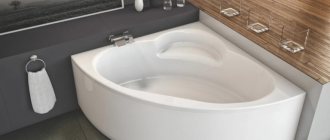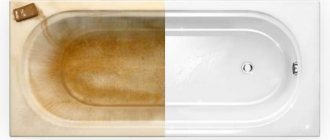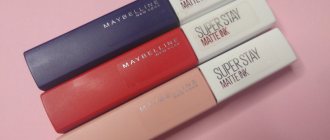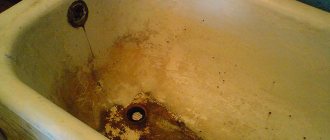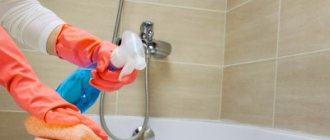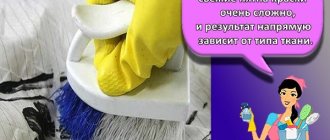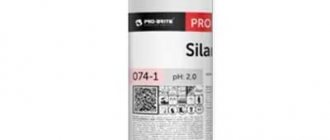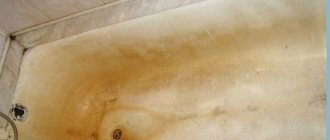An acrylic bathtub has a number of advantages over similar products made of cast iron or steel.
- High plasticity allows you to create all sorts of shapes for this miracle of plumbing, and also fit into any size room for water treatments without any problems.
- The light weight of the material greatly simplifies the installation of the finished product.
- The slow heat transfer of acrylic makes it possible to maintain a comfortable body temperature for a long time and fully relax after a busy day of work.
And although heavy cast iron bathtubs coated with enamel are more durable, knowing how to care for acrylic sanitary ware will extend their service life for a long time.
How to clean an acrylic bathtub using folk remedies?
Clean the bath
Traditional soda, vinegar or citric acid will help.
To clean
with citric acid or vinegar, you need to fill
the bathtub
with water and pour in/pour the cleaning agent into it. Leave for 10-15 minutes. Afterwards rinse with running water.
Interesting materials:
When can Spirea be planted? When can you plant cyclamen? When can you plant iris flowers? When can you plant dill in August? When can you plant alyssum in the ground? When can you plant balsam? When can you plant bamboo in the ground? When can you plant marigolds in the ground? When can you plant periwinkle? When can you plant hawthorn?
If the bathtub has turned yellow, what to do?
The most common problem that owners of acrylic bathtubs and shower cabins encounter is yellowing. This happens for several reasons:
- using “dangerous” cleaning products;
- too hard water provokes the formation of plaque;
- a fairly long period of operation and considerable “age” of the bath.
Accordingly, yellow plaque should be removed, focusing on the factor of its appearance. In the first case, you need to review your arsenal of detergents and eliminate the use of those that harm the surface. In the second, add a small amount of a special softening component to the water. Third, systematically use bleach.
Tip : It is not necessary to use a mass production product from the chemical industry. Regular lemon juice works great for yellowing (rub the surface, leave for 8 hours, rinse with warm water, wipe dry with a soft cloth). In addition, this is the best way to disinfect the bath before bathing your baby.
Professional products
If traditional methods do not help, you can use special cleaning products. Among the popular ones:
- Cif. This cleaning cream can be used not only for acrylic bathtubs, but also for other plumbing fixtures. Effectively and delicately removes different types of dirt.
- "Acrilan". Available in the form of foam, which is applied to the dirt for 10 minutes. Then it must be washed off and the surface wiped dry. Foam should not be mixed with other products and should not be allowed to dry on acrylic.
- Bass. Presented in the form of a spray that is convenient to spray. After use, it must be washed off.
- "Cinderella". A fast-acting product with a strong odor. It should be applied with rubber gloves. The cleaning result will be noticeable within a few minutes. According to the instructions, it is recommended to wait 7 minutes, then rinse with plenty of water and wipe dry.
- Another special Ravak detergent . Available as a spray or paste by the acrylic bathtub manufacturer.
- “Chister”, “Tim-Profi” use these special tools in the same way. They are applied to the surface, wait for the time specified in the instructions, then rinse off and wipe dry.
Carefully! “Pemolux”, “Sanox”, “Domestos” can clean the bathtub white. But they contain aggressive hydrochloric acid, which destroys the protective coating. Immediately after cleaning, the bathtub will become snow-white, but then dirt will stick to it much faster. Therefore, such means cannot be used.
How to get rid of different types of dirt
Methods for cleaning an acrylic bathtub depend on the type of dirt that appears on it. Typical - water stone, limescale, rust.
Water stone and limescale
Water stone or limescale deposits form on the bowl if tap water contains a lot of metals in its composition. If the water is like this, then it is better not to allow the stone to build up. To do this, you should rinse the bathtub with warm water after each use. If the bathtub still turns yellow, then you can deal with the stains like this:
- Fill the bathtub with water at a temperature of 25-30 degrees. The water level is such that the sediments are completely underneath it.
- Pour in half a bottle of vinegar and add 1 pack of citric acid.
- Stir and leave overnight, if possible, for 12 hours.
- Drain the water and rinse off the remaining solution, wipe dry.
- If this procedure does not help, then you should clean the acrylic bathtub from yellowness with special products recommended by the manufacturer.
Rust
It is possible to clean an acrylic bathtub from rust, but you need to do it correctly. Rust holds tightly to inexpensive acrylic bathtubs that are only coated with polymer. The appearance of yellow rust spots is the result of using unfiltered tap water and faulty plumbing.
Advice! After each use of the bath, rinse it with water and wipe dry. If rusty streaks do appear, you should deal with them.
Lemon acid. Dissolve 1 package of citric acid with 200 ml of water, stir until the acid crystals dissolve. Apply with a sponge or soft cloth to contaminated areas. Rinse off with warm water.
Ammonia and peroxide. For rust stains, you can very carefully use a mixture of ammonia and hydrogen peroxide. These components need to be mixed in equal parts, wet the sponge and rub the stain. The result will be noticeable immediately.
Some useful tips for caring for acrylic bathtubs
In conclusion of the publication, summing up all of the above, we can repeat ourselves somewhat, highlighting the key points that are important to consider when caring for acrylic plumbing fixtures:
- In order not to have to deal with the very laborious, time-consuming and effort-consuming work of cleaning a heavily soiled bathtub, it is recommended to wash it regularly, after each water treatment.
- It is necessary to monitor the serviceability of water taps and showers - there should not even be signs of water leaks anywhere. All faucets should be tightly closed after each use. This way you can avoid the appearance of hard-to-remove yellow rust stains on the surface of the bowl.
- It is recommended to rinse the bathtub with hot water, which will add shine to the acrylic.
- Before choosing and using a new detergent, you should carefully study its composition and method of use. It is better to test it on an inconspicuous small area of the surface.
- It is necessary to protect acrylic surfaces from mechanical influences, from contact with sharp objects, as well as from animal claws.
- You cannot place a stool on the bottom of the bathtub, using it, for example, as a support for the basin during hand washing. Point pressure from its legs will certainly lead to damage to the acrylic surface.
- If coloring substances get on the surface, they should be removed immediately, not allowing them to be absorbed into the pores of the polymer. Stubborn stains will be very difficult to remove.
- It is recommended to keep the bathtub dry, so it is advisable to wipe it with a soft, moisture-absorbing cloth each time after use and cleaning.
* * * * * * *
If you thoroughly understand all the nuances of caring for acrylic bathtubs and their minor repairs, it will be easier to cope with both prevention and cleaning. The main thing is not to make difficult-to-correct mistakes in this matter. In addition, who knows, it is possible that, after reading the information, some homeowners who are thinking of replacing their steel or cast iron bathtub with a fashionable acrylic model will abandon this idea altogether.
In conclusion, an educational video about caring for an acrylic bathtub.
Using Sanox
This is a more affordable analogue of Domestos. Its main active ingredient is hydrochloric acid. The product is produced in the form of gel, spray and foam. Sanox is used for removing complex stains, disinfecting and bleaching. You need to work with it wearing gloves and a respirator.
A small amount of product is applied to a sponge and evenly distributed over the moistened walls. After 3 minutes, wipe the surface and rinse with water. If necessary, repeat the procedure.
Sanox carefully removes dirt and effectively fights germs.
Is it possible to wash with white at home?
Whitening can certainly remove tough stains from a variety of surfaces. But at the same time, you need to remember that this product is very aggressive for such a delicate sanitary ware and you cannot clean the bathtub with it. The danger of using it is that after several cleaning procedures, the acrylic coating becomes very porous. As a result, dirt, rust and salt deposits settle in these places “tightly”, the surface of the bathtub deteriorates to such an extent that it is often beyond repair. Also, chlorine causes yellowness, which is extremely undesirable for any housewife.
So you’ve learned how to safely clean an acrylic bathtub using both commercial and folk remedies. One or more of them is sure to be found in every woman’s household.
Acrylic bathtubs are a good alternative to heavy cast iron and quickly cooling steel ones. These products are not subject to corrosion and contain special antibacterial components that block the growth of fungus and mold. With care and the right approach to washing, such plumbing fixtures can serve their owners for a long time without fading and pleasing the eye with their bright whiteness.
Traditional methods
Some of them can be safely used to remove stains from your bathtub.
Often used to remove stains and plaque:
- citric acid;
- liquid soap;
- soda;
- hydrogen peroxide;
- toothpaste;
- ammonia;
- laundry and baby soap;
- vinegar;
- whiteness, etc.
Vinegar
To remove contaminants, you cannot use 72% vinegar essence: this will damage the structure of the acrylic. It is recommended to clean the bathtub with a 9% solution. Vinegar is good at removing plaque and yellowing caused by high chlorine content.
Liquid soap
It copes well with the gray coating that occurs during daily use of the bathtub. Apply the product to the sponge, carefully treat all the walls with it and leave it for a quarter of an hour. After this, thoroughly wipe the surface again. Then the remaining liquid soap is washed off with plenty of water.
After this, the acrylic coating must be dried with a soft cloth and treated with polish.
Soda
It is an abrasive, so in its pure form it is not used to clean the bathtub, because... will leave severe scratches on the coating. It is safer to use a solution to bleach the surface.
First, the bathtub is filled to the brim with warm water. Then add 1 pack of soda to the liquid. The solution is left for 1 hour. After this, you need to drain it and rinse the walls.
To remove old stains, use a paste of baking soda. To prepare it, the substance is poured into a glass plate and a little water is added there. The composition is stirred until the crystals dissolve. The mixture should acquire a creamy consistency. Dilute soda is applied to the contaminated areas. After 20 minutes, wash off the remaining product with plenty of water.
A baking soda solution is perfect for removing dirt from acrylic surfaces.
Citric acid (juice)
Citric acid powder is most often used, but juice can also be used. The first option is the most convenient. However, the crystalline substance is not used in its pure form, because it is abrasive and may damage the finish.
First, the powder is diluted in water until completely dissolved. After this, it is applied with a sponge to the walls of the bath. After 15 minutes, wash off the residue and dry the surface with a soft cloth.
Hydrogen peroxide
It is often used in combination with vinegar. This enhances the effect of both components. To prepare the cleaning composition, mix 3 parts vinegar and 1 part hydrogen peroxide. Using a sponge, carefully treat the bath with the resulting product. After about 15 minutes, wipe the surface well. This will help remove old stains. Then you need to wash off the remaining mixture and wipe the surface with a dry cloth.
Laundry soap
It is recommended to use low fat soap. First you need to grind it thoroughly. To do this, you can use a grater or razor.
The shavings are diluted with water until a homogeneous gel is obtained. To enhance the cleaning properties, add 2 tbsp. soda There should be no crystals in the finished product. Using a sponge, you need to spread the paste over the walls. After an hour, the mixture of laundry soap and soda is washed off with plenty of water.
Ammonia
It is used together with hydrogen peroxide to remove rust and limescale.
The components are mixed in equal proportions. Using a sponge, spread the product over the surface, leave for 5 minutes and then rinse with water.
Ammonia contains ammonia, so prolonged exposure to the product will damage the acrylic coating.
Ammonia is a common means of removing rust from the surface of acrylic bathtubs.
Disinfection with “Whiteness”
“Belizna” contains chlorine, so the product cannot be used in its pure form, because its active substance will react with acrylic, which will lead to darkening of the coating. In this case, it is permissible to use “Whiteness” in a diluted form to eliminate bacteria and fungi.
To prepare a safe solution, 1 tbsp. Add the product to 1 bucket of warm water. Then the surface is thoroughly washed with the resulting composition. After this, the bath is rinsed and wiped with a dry soft cloth.
Baby soap
It is recommended to be used for daily care. It removes yellowness and limescale. The soap is pre-rubbed. A well-moistened sponge is dipped in fine shavings. Then the surface is thoroughly treated with the product. After this, the remaining soap is washed off from the bath.
Toothpaste
It is considered the best folk remedy for cleaning acrylic surfaces. Due to its high cost, it is often used to remove particularly persistent contaminants, incl. caused by contact of the coating with gouache, hair dye, etc. To clean the bathtub, squeeze out about ½ tube of paste onto a sponge. Then the product is thoroughly rubbed into the contaminated area and left for 10 minutes. After this, the coating is washed with warm water and dried with a soft cloth.
Is it possible to clean the font from yellowness and limescale with a melamine sponge?
Nowadays, melamine sponges , which consist entirely of melamine, an organic compound that is colorless crystals, are gaining immense popularity.
This substance, after reacting with water, turns into a cleaning agent and “absorbs” all contaminants into its structure.
These sponges are perfect for cleaning an acrylic bathtub, because... They do an excellent job of removing rust, yellow stains and plaque. At the same time, they are very gentle on the bathtub coating.
Compatibility of detergents with acrylic surfaces
Is it possible to wash an acrylic bathtub with Domestos or a mixture of substances? It is not advisable to mix with:
- Formaldehyde - they are not compatible with acrylic.
- Chlorine - its use forms pores, shortening the service life of the product.
- Acetone , ammonia - corrode the walls.
Domestos, Sanox, Pemolux and Selite contain hydrochloric acid, which destroys protection. Initially, it is bleached, but then it absorbs plaque, becoming dirty faster. Therefore, such detergents cannot be used.
Features of cleaning whirlpool baths
The hydromassage bath is equipped with special sprayers that are connected to a circulation pump. It is this that creates the pressure of water, which under strong pressure comes out through the nozzles in a given direction. Moisture should not accumulate in the nozzles, as this leads to mold growth and the proliferation of microorganisms. The cleaning process for such a bathtub is as follows:
- The bowl is filled with hot water, the level is 5-7 cm above the nozzles.
- Water circulation is turned on.
- 50 ml of liquid is poured into the bath, which is used to clean dishwashers.
- The hydromassage mode is switched on for 15 minutes.
- All that remains is to drain the water and start the hydromassage mode with clean water. This will help flush the injectors.
How to remove scratches
If scratches do appear on the bathroom, they can and should be eliminated to avoid further damage to the material. Cracks, chips and defects that form when the surface is corroded by aggressive substances also require restoration.
Acrylic bathtubs are easy to restore, so minor defects can be removed at home. Scratches can be removed fairly quickly:
- the damaged areas are carefully sanded with sandpaper of different grain sizes (from coarse to fine);
- A special polishing compound is applied to the cleaned area and treated with a fleece or special cloth in accordance with the instructions.
Note: Small scratches can be removed with a special polishing pencil for acrylic surfaces.
Serious defects can be eliminated using putty, liquid acrylic and polish. Often such work is entrusted to professionals, but if you wish, you can do it yourself in several stages:
- Use masking tape to separate defects from undamaged areas;
- cracks and chips are sealed with starting putty;
- after the putty layer has dried, the damaged areas are rubbed first with coarse-grained sandpaper, then with fine-grained sandpaper;
- if small unevenness remains, add a layer of finishing putty and, after it has dried, sand the surface again with fine-grained sandpaper;
- remove the masking tape and degrease the surface with alcohol;
- after all layers of putty have completely dried, a special paint is applied to the treated areas (its color is selected in accordance with the shade of the bathtub);
- Finally, polish is applied to the dried layer of paint.
For convenience, you can purchase a repair kit for acrylic bathtubs. The standard kit includes polish, a set of sandpaper of different grits and polishing cloth.
Repair kit for acrylic.
Step by step how to remove scratches is described in the video below:
Bathtub operating rules
The acrylic surface does not tend to absorb dirt, but it is important to properly care for the coating:
- clean it after every bath;
- keep container dry when not in use;
- Regularly treat the surface with polish.
This will prevent the formation of dark deposits and enhance the dirt-repellent properties of the coating.
It is difficult to remove rust from acrylic, so you need to make sure that the faucet and shower are in good working order. Drops that constantly fall on the surface lead to the formation of stubborn stains.
In addition, it is not recommended to frequently use aggressive detergents: this will negatively affect the coating.
